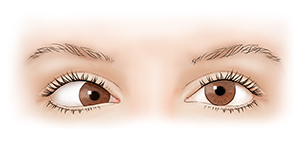Understanding Sixth Nerve Palsy
Sixth nerve palsy is a problem with eye movement. It happens because of a problem with the sixth cranial nerve. This is also called the abducens nerve. In some cases, sixth nerve palsy is present at birth. It can also result from other problems that occur later on. In adults, stroke is one of the most common causes of sixth nerve palsy.
How the sixth cranial nerve affects the eye
The sixth cranial nerve sends signals to a small muscle that attaches to the outer side of each eye. When this muscle contracts, the eye turns outward, away from the nose. Each eye has its own cranial nerve, the sixth nerve.
What causes sixth nerve palsy?
The sixth nerve comes from the lower part of the brain. It’s a long nerve. Damage at any point on the nerve can cause it to work poorly or not at all. If this happens, the muscle attached to the outer side of the eye won’t get signals. It then won’t contract correctly. Your eye will turn inward toward your nose.
 |
| With sixth nerve palsy, one eye may turn inwards towards the nose. |
Many problems can disrupt the function of the sixth cranial nerve and cause sixth nerve palsy. Possible causes include:
-
Injury, especially a skull fracture
-
Stroke
-
Infection, such as Lyme disease or a virus
-
Brain tumor
-
Inflammation of the nerve, such as from a disease like multiple sclerosis
-
Increased pressure in the brain, from meningitis or other causes
-
High blood pressure
-
Diabetes
-
Diseases that are present at birth (congenital diseases)
In some cases, the cause of sixth nerve palsy is not known. Sometimes other conditions can cause symptoms that look like sixth nerve palsy. These include thyroid disease and myasthenia gravis.
Symptoms of sixth nerve palsy
Sixth nerve palsy may affect one or both eyes, depending on its cause.
The most common symptom of sixth nerve palsy is double vision when both eyes are open. This is more common when looking far away or when looking in the direction of the affected eye. Not everyone with sixth nerve palsy has this symptom.
Your eyes may also be out of alignment. This is called strabismus. The eye on the affected side may turn toward the midline. Early on you may have this only when looking in the direction of the affected eye. If the palsy gets worse, the eye may turn toward the midline even when you look straight ahead.
Other symptoms may include:
Diagnosing sixth nerve palsy
The healthcare provider will ask about your health history and symptoms. You will have a physical exam. This will include a detailed neurological exam. This type of exam uses tests to see which parts of your brain and nervous system may be affected. You may be examined by a neurologist or a neuro-ophthalmologist. These are healthcare providers who specialize in the nervous system. The healthcare provider will also try to diagnose the cause of the sixth nerve palsy.
You may have brain imaging tests, such as CT scan or MRI.
You may need other tests to find the cause of sixth nerve palsy. These may include blood tests or a lumbar puncture to look for an infection, such as meningitis.
Treatment for sixth nerve palsy
Sixth nerve palsy is treated by treating the underlying cause. This might be diabetes or high blood pressure. Infections are treated with antibiotics or antiviral medicines. You may need surgery to treat tumors or increased brain pressure. An eye patch can reduce double vision. Surgery on the eye muscle or botulinum toxin injection can be used to treat double vision that doesn't go away on its own.